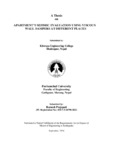Please use this identifier to cite or link to this item:
https://elibrary.khec.edu.np/handle/123456789/861| Title: | Apartment's Seismic Evaluation Using Viscous Wall Dampers at Different Places |
| Authors: | Ramesh Prajapati |
| Advisor: | Dr. Purusotam Dangol; Mr. Suraj Malla |
| Issue Date: | 2024 |
| College Name: | Khwopa Engineering College |
| Level: | Masters |
| Degree: | ME Earthquake |
| Department Name: | P. G. Department of Earthquake Engineering |
| Abstract: | The demand for high-rise apartment buildings in Nepal has surged due to urban population growth and limited space. However, these structures require special care to ensure earthquake resistance, as ground motion can cause significant damage. Viscous Wall Dampers (VWDs) are energy dissipation devices that improve structural stability, especially during earthquakes. Although commonly used worldwide, their implementation in Nepal remains limited. The practice of response-based design using seismic energy dissipating devices such as Viscous Wall Dampers in high rise apartment building is common in many developed and developing countries however it is rare in the case of Nepal. In this study 3D Non-linear Time History Analysis using ETABS V21 is applied for the seismic response analysis considering code prescribed earthquake ground motion testing different sets and placements of VWDs. VWDs were placement at least two dampers in one direction in plan with varying number of dampers with the elevation. An attempt is made to capture the comparative behavior of the structure by explicitly modeling of viscous wall damper and dual system modeling to study the comparative responses of adopted 12 sets and 4 models of each set. Out of 48 models 12 building models are selected as one model from each set for comparative study based on considered damping percentage and seismic response parameters. From analysis, it is found that the displacement is decreased by 0.7% in S3M9, 6.7% in S4M13, 9% in S8M29, 8.3% in S9M33 and is increased by 3.6% in S7M25 as compare to site case. The inter-story drift ratio is decreased by 10.7% in S8M29, and is increased by 0.8% in S3M9, 3.6% in S7M25 as compare to site case. The base shear is decreased by 2.9% in S3M9, 6% in S7M25 and is increased by 1.8% in S8M29 as compare to site case. In conclusion, according to result of base reaction, displacement, drift and other response parameter, it is observed that responses among 48 models, model S3M9 is one of the best placements of dampers and has minimum number of dampers (twenty). After that model S8M29 is best placement of dampers (twenty-four) to get better seismic response among S2M5, S4M13, S6M21, S9M33, S10M37, S1141 and S12M45. The analysis suggests that careful placement of dampers can significantly improve the earthquake resilience of high-rise buildings in Nepal. |
| URI: | https://elibrary.khec.edu.np:8080/handle/123456789/861 |
| Appears in Collections: | Master of Science (M.Sc) in Earthquake engineering |
Files in This Item:
| File | Description | Size | Format | |
|---|---|---|---|---|
| 021_Ramesh Prajapati.pdf Restricted Access | 9.12 MB | Adobe PDF |  View/Open Request a copy |
Items in DSpace are protected by copyright, with all rights reserved, unless otherwise indicated.
